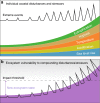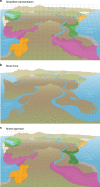Representing the function and sensitivity of coastal interfaces in Earth system models
- PMID: 32424260
- PMCID: PMC7235091
- DOI: 10.1038/s41467-020-16236-2
Representing the function and sensitivity of coastal interfaces in Earth system models
Abstract
Between the land and ocean, diverse coastal ecosystems transform, store, and transport material. Across these interfaces, the dynamic exchange of energy and matter is driven by hydrological and hydrodynamic processes such as river and groundwater discharge, tides, waves, and storms. These dynamics regulate ecosystem functions and Earth's climate, yet global models lack representation of coastal processes and related feedbacks, impeding their predictions of coastal and global responses to change. Here, we assess existing coastal monitoring networks and regional models, existing challenges in these efforts, and recommend a path towards development of global models that more robustly reflect the coastal interface.
Conflict of interest statement
The authors declare no competing interests.
Figures





References
-
- US Department of Energy. Research priorities to incorporate terrestrial–aquatic interfaces in Earth system models workshop (DOE, 2017).
-
- Canuel EA, Cammer SS, McIntosh HA, Pondell CR. Climate change impacts on the organic carbon cycle at the land–ocean interface. Annu. Rev. Earth Planet. Sci. 2012;40:685–711. doi: 10.1146/annurev-earth-042711-105511. - DOI
-
- Costanza R, et al. Twenty years of ecosystem services: how far have we come and how far do we still need to go? Ecosyst. Serv. 2017;28:1–16. doi: 10.1016/j.ecoser.2017.09.008. - DOI
-
- Martínez ML, et al. The coasts of our world: ecological, economic and social importance. Ecol. Econ. 2007;63:254–272. doi: 10.1016/j.ecolecon.2006.10.022. - DOI
-
- International Chamber of Shipping. Shipping and world trade. ICShttps://www.ics-shipping.org/shipping-facts/shipping-and-world-trade (2020).
Publication types
LinkOut - more resources
Full Text Sources

